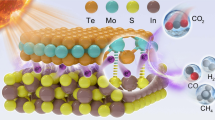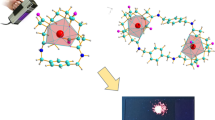Abstract
Crystalline BiVO4:Eu3+ nanomaterials have been successfully synthesized by four different methods: co-precipitation, hydrothermal, solvothermal, and reverse micelles. The relationship between crystal structure and luminescent properties was studied by X-ray diffraction and steady-state fluorescence. The data indicate that Eu3+ 5D0 → 7F2 red luminescence at 618 nm can be excited by visible light at 466 nm in BiVO4 host. Furthermore, it has been found that the encapsulation of europium(III) in tetragonal phase (BiVO4) results in enhanced luminescence intensities compared with monoclinic phase. Transmission electron microscopy showed rods with sizes ranging from nanometer to micrometer and nanospheres can be obtained under different experimental conditions.











Similar content being viewed by others
References
Anitha M, Ramakrishnan P, Chatterjee A, Alexander G, Singh H (2002) Spectral properties and emission efficiencies of GdVO4 phosphors. Appl Phys A 74:153–162
Bierlein JD, Sleight AW (1975) Ferroelasticity in BiVO4. Solid State Commun 16:69–70
David WIF (1983) Ferroelastic phase transition in BiVO4: III. Thermodynamics. J Phys C Solid State Phys 16:5093–5118
Deki S, Lizuka S, Mizuhata M, Kajinami A (2005) Fabrication of nanostructured materials from aqueous solution by liquid phase deposition. J Electroanal Chem 584:38–43
Feng X, Yang L, Zhang NC, Liu YL (2010) A facile one-pot hydrothermal method to prepare europium-doped titania hollow phosphors and their sensitized luminescence properties. J Alloys Compd 506:728–733
Frost RL, Dermot A, Henry ML et al (2006) Raman spectroscopy of three polymorphs of BiVO4 clinobisvanite, dreyerite and pucherite, with comparisons to (VO4)3− bearing minerals namibite, pottsite and schumacherite. J Raman Spectrosc 37:722–732
Hirota K, Komatsu G, Yamashita M, Takemura H, Yamaguchi O (1992) Formation, characterization and sintering of alkoxy-derived bismuth vanadate. Mater Res Bull 27:823–830
Huang HH, Yan B (2006) Sol-gel synthesis of YxGd2_xSiO5:Eu3+ phosphors derived from the in situ assembly of multicomponent hybrid precursors. Opt Mater 28:556–559
Huignard A, Gacoin T, Boilot JP (2000) Synthesis and luminescence properties of colloidal YVO4:Eu phosphors. Chem Mater 12:1090–1094
Jia CJ, Sun LD, Luo F, Jiang XC, Wei LH, Yan CH (2004) Structural transformation induced improved luminescent properties for LaVO4:Eu nanocrystals. Appl Phys Lett 84:5305–5307
Jia CJ, Sun LD, Yan ZG, Pang YC, Lu SZ, Yan CH (2010) Monazite and zircon type LaVO4:Eu nanocrystals—synthesis, luminescent properties, and spectroscopic identification of the Eu3+ sites. Eur J Inorg Chem 2626–2635. doi:10.1002/ejic.201000038
Justel T, Nikol H, Ronda C (1998) New developments in the field of luminescent materials for lighting and displays. Angew Chem Int Ed 37:3084–3103
Kohtani S, Makino S (2002) Photocatalytic degradation of 4-n-nonylphenol under irradiation from solar simulator: comparison between BiVO4 and TiO2 photocatalysts. Chem Lett 7:660–661
Kudo A, Omori K, Kato H (1999) Novel aqueous process for preparation of crystal form-controlled and highly crystalline BiVO4 powder from layered vanadates at room temperature and its photocatalytic and photophysical properties. J Am Chem Soc 121:11459–11467
Lee GH, Kim TH, Yoon CL, Kang SH (2008) Effect of local environment and Sm3+-codoping on the luminescence properties in the Eu3+-doped potassium tungstate phosphor for white LEDs. J Lumin 128:1922–1926
Leroy CM, Cardinal T, Jubera V, Treguer-Delapierre M, Majimel J, Manaud JP, Backov R, Boissière C, Grosso D, Sanchez C, Viana B, Pellé F (2008) Europium-doped mesoporous titania thin films: rare-earth locations and emission fluctuations under illumination. Chem Phys Chem 9:2077–2084
Manolikas C, Amelinckx S (1980) Ferroelastic domains in BiVO4. Phys Status Solidif 60:167–172
Molina C, Dahmouche K, Santilli CV, Craievich AF, Ribeiro SJL (2001) Structure and luminescence of Eu3+-doped class I siloxane-poly(ethylene glycol) hybrids. Chem Mater 13:2818–2823
Neeraj S, Kijima N, Cheetham AK (2004) Novel red phosphors for solid state lighting; the system BixLn1−xVO4; Eu3+/Sm3+ (Ln = Y, Gd). Solid State Commun 131:65–69
Ren L, Jin L, Wang JB, Yang F, Qiu MQ, Yu Y (2009) Template-free synthesis of BiVO4 nanostructures: I. Nanotubes with hexagonal cross sections by oriented attachment and their photocatalytic property for water splitting under visible light. Nanotechnology 20:15603
Riwotzki K, Haase M (1998) Wet-chemical synthesis of doped colloidal nanoparticles: YVO4:Ln (Ln = Eu, Sm, Dy). J Phys Chem B 102:10129–10135
Sayama K, Nomura A, Zou ZG, Abe R, Abe Y, Arakawa H (2003) Photoelectrochemical decomposition of water on nanocrystalline BiVO4 film electrodes under visible light. Chem Commun 23:2908–2910
Shantha K, Varma KBR (1999) Preparation and characterization of nanocrystalline powders of bismuth vanadate. Mater Sci Eng B 60:66–75
Smith HM (2002) Toxicology and ecotoxicology issues with high performance pigments. In: High performance pigments Wiley, Weinheim, p 411–417
Sun YF, Xie Y, Wu CZ, Long R (2010) First experimental identification of BiVO4·0.4H2O and its evolution mechanism to final monoclinic BiVO4. Cryst Growth Des 10:602–607
Tokunaga S, Kato H, Kudo A (2001) Selective preparation of monoclinic and tetragonal BiVO4 with Scheelite structure and their photocatalytic properties. Chem Mater 13:4624–4628
Yan B, Su XQ (2006) Chemical co-precipitation synthesis of luminescent BixY1−xVO4:RE (RE = Eu3+, Dy3+, Er3+) phosphors from hybrid precursors. J Non Cryst Solids 352:30–31
Yu JQ, Kudo A (2006) Effects of structural variation on the photocatalytic performance of hydrothermally synthesized BiVO4. Adv Funct Mater 16:2163–2169
Acknowledgments
Q. M. appreciates National Natural Science Foundation of China (21002035) and Start fund of Guangdong Talents C10208.
Author information
Authors and Affiliations
Corresponding author
Electronic supplementary material
Below is the link to the electronic supplementary material.
Rights and permissions
About this article
Cite this article
Wang, Q., Li, Y., Zeng, Z. et al. Relationship between crystal structure and luminescent properties of novel red emissive BiVO4:Eu3+ and its photocatalytic performance. J Nanopart Res 14, 1076 (2012). https://doi.org/10.1007/s11051-012-1076-1
Received:
Accepted:
Published:
DOI: https://doi.org/10.1007/s11051-012-1076-1




